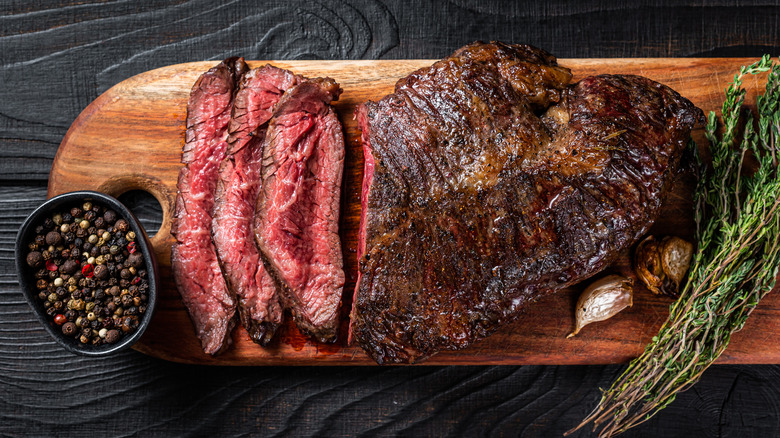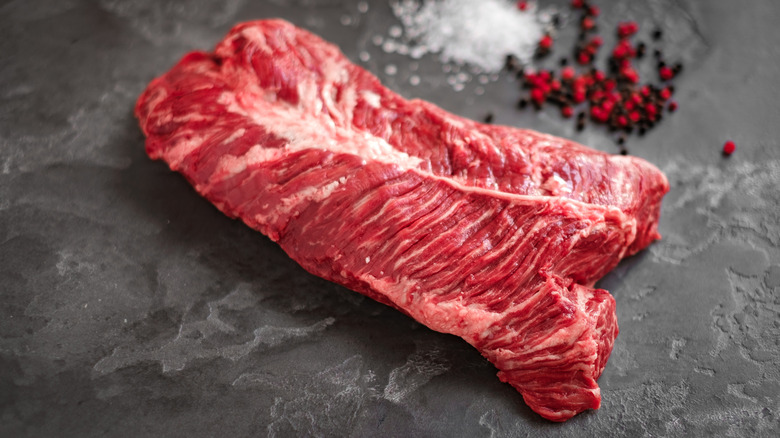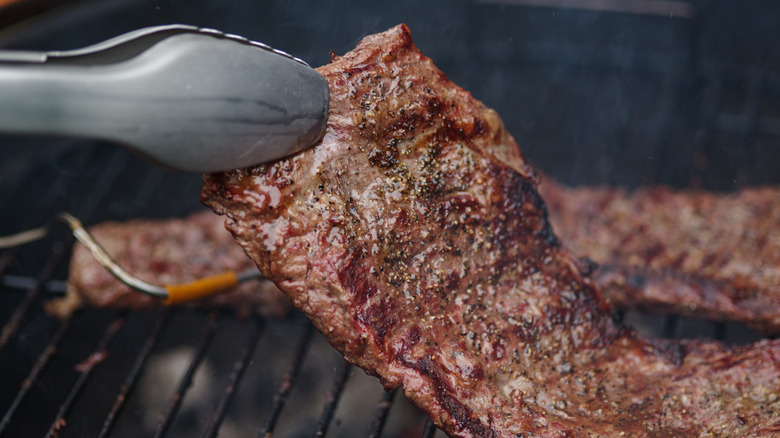Why The Hanger Steak Cut Is Prized By Butchers
In the food business, secrets have a way of getting around. From KFC's signature spice blend to most fast food secret menu items, it seems that culinary secrets rarely stay secret for long; case in point, the hanger steak. Up until the late 20th century, most Americans had never heard the name "hanger steak". But during this time, the cut was considered a trade secret amongst butchers. They appreciated the cut's rich taste, so they set it aside for their own enjoyment.
But butchers couldn't keep the hanger steak to themselves forever though, as across the Atlantic, in the beef-laden bistros of France, the cut was celebrated by the name "onglet". It was only a matter of time before the rest of the world caught on. Today, the hanger steak goes by many names, depending on where you are. In Italy, it is known as "lombatello." In Spain, it goes by "solomillo de pulmón," and in the United Kingdom, they call it "skirt steak," which shouldn't be confused with American skirt steak – in the United States, skirt steak is a different, but similar cut.
Hanger steak is one of the three flat steaks — along with flank steak and (American) skirt steak — so called because all three are quite thin compared to other cuts of beef. Best cooked at a high heat and fast, these cuts are ideal for backyard grilling. But the hanger steak is a level above the other two in terms of flavor and texture; the secret lies in its particular position within the cow's body.
What is hanger steak?
Hanger steak comes from the belly of the cow, where it hangs between the animal's ribs and loins, supporting its diaphragm. That's why we call it a "hanger steak" or a "hanging tenderloin". The hanger steak is shaped like a V, with a thick membrane running right down the center. When it's laid flat, the lines of muscle extending from the center line look almost like a feather. The membrane is so tough, that it's inedible, and you'll have to cut around it either before or after cooking; however, this minor nuisance is well worth the extra few seconds of knife work required, considering the vaunted qualities of hanger steak.
The more a cow uses a particular muscle, the tougher the corresponding cut of beef will be. Hanger steak comes from an inactive muscle, and aside from the central membrane, it's among the most tender cuts in the whole cow, far more so than its cousins, flank steak and skirt steak. It also has generous marbling, which amplifies both its flavor and tenderness.
Hanger steak offers tenderness and flavor on par with more pricey rib steaks and tenderloins, but it's far less expensive. Price-wise, it's comparable to the other flat steaks: skirt and flank. The only downside is that hanger steaks can be hard to come by. It's tough to mass market this cut because each cow yields only one hanger steak. You're more likely to find hanger steak at a butcher than at a supermarket.
How to cook hanger steak
Flat steaks like the hanger steak are best cooked on the grill, using high heat and a short cooking period. Any type of grill will do the job, but charcoal grills are preferred because they can reach higher temperatures than gas grills. This will help you get a nice, flavorful crust on your steak while the inside stays pink and juicy. If you don't have an outdoor space for grilling, don't worry, as a ripping-hot cast iron pan can also do the job quite nicely.
Although the hanger steak is famously tender, it is composed of rather thick muscle fibers, which can turn tough if you overcook them. For this reason, hanger steaks need to be cooked to medium-rare or medium at the most. The best way to ensure a properly cooked steak is to use a meat thermometer. Aim for 125 degrees Fahrenheit for a medium-rare steak and 130 degrees Fahrenheit for a medium one.
Like the other flat steaks, hanger steak works great in marinated dishes like fajitas and tacos. Using a marinade is another way to ensure that your steak stays nice and tender when you cook it. It's best to use marinades with acidic ingredients like citrus juice or vinegar, as these will help to break down the muscle fibers. When it comes time to serve, be sure to cut the meat against the grain, ensuring a tender bite every time.


